Contemporary Indigenous Health: A Reflective Essay on Wellbeing
VerifiedAdded on 2023/06/03
|10
|2207
|183
Essay
AI Summary
This essay provides a reflective analysis of contemporary Indigenous health and wellbeing, focusing on the social and cultural implications of healthcare engagement for Indigenous Australians. It explores pre-existing assumptions regarding the causes of poor health outcomes, particularly the impact of colonization and socioeconomic factors. The essay reviews the subject matter, emphasizing the value of yarning circles, community engagement, and simulation-based learning in understanding and addressing Indigenous healthcare needs. It further discusses the importance of cultural competency, ABCD cultural assessments, and the integration of Indigenous Graduate Attributes and Registered Nurse standards in nursing practices. The reflection underscores the need for culturally sensitive and evidence-based approaches to improve healthcare access and outcomes for Aboriginal and Torres Strait Islander peoples, highlighting the role of nursing in promoting equitable and respectful care.
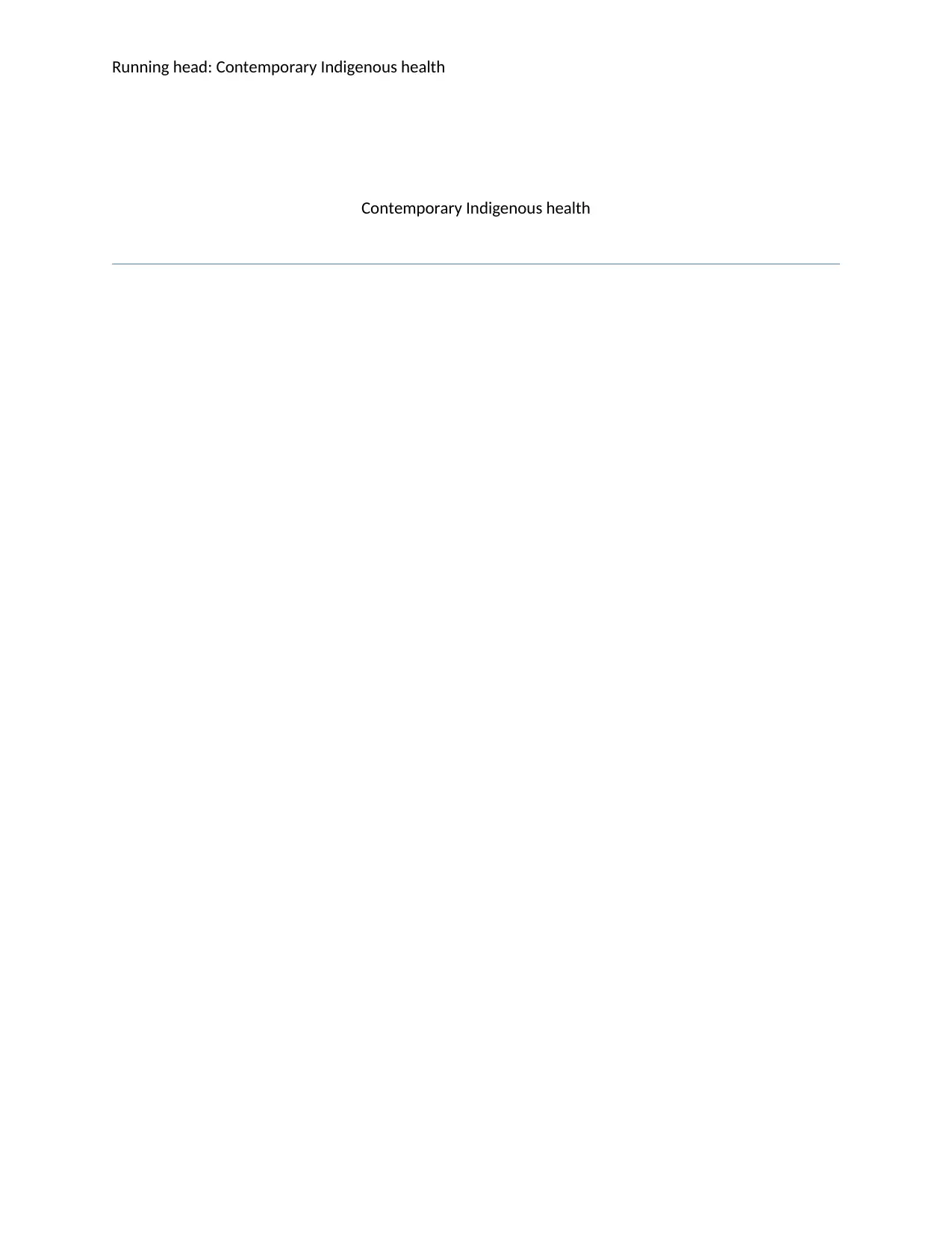
Running head: Contemporary Indigenous health
Contemporary Indigenous health
Contemporary Indigenous health
Paraphrase This Document
Need a fresh take? Get an instant paraphrase of this document with our AI Paraphraser
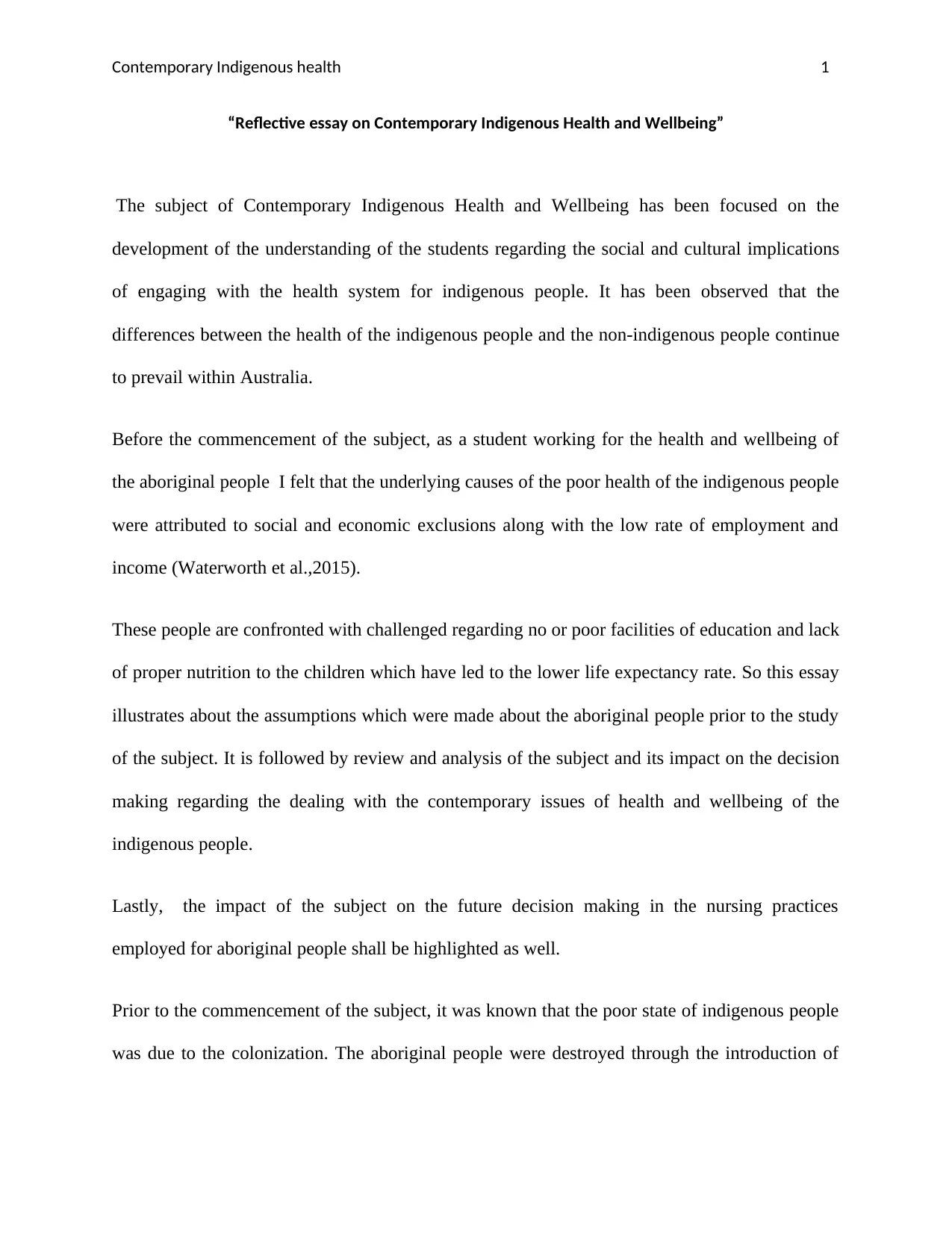
Contemporary Indigenous health 1
“Reflective essay on Contemporary Indigenous Health and Wellbeing”
The subject of Contemporary Indigenous Health and Wellbeing has been focused on the
development of the understanding of the students regarding the social and cultural implications
of engaging with the health system for indigenous people. It has been observed that the
differences between the health of the indigenous people and the non-indigenous people continue
to prevail within Australia.
Before the commencement of the subject, as a student working for the health and wellbeing of
the aboriginal people I felt that the underlying causes of the poor health of the indigenous people
were attributed to social and economic exclusions along with the low rate of employment and
income (Waterworth et al.,2015).
These people are confronted with challenged regarding no or poor facilities of education and lack
of proper nutrition to the children which have led to the lower life expectancy rate. So this essay
illustrates about the assumptions which were made about the aboriginal people prior to the study
of the subject. It is followed by review and analysis of the subject and its impact on the decision
making regarding the dealing with the contemporary issues of health and wellbeing of the
indigenous people.
Lastly, the impact of the subject on the future decision making in the nursing practices
employed for aboriginal people shall be highlighted as well.
Prior to the commencement of the subject, it was known that the poor state of indigenous people
was due to the colonization. The aboriginal people were destroyed through the introduction of
“Reflective essay on Contemporary Indigenous Health and Wellbeing”
The subject of Contemporary Indigenous Health and Wellbeing has been focused on the
development of the understanding of the students regarding the social and cultural implications
of engaging with the health system for indigenous people. It has been observed that the
differences between the health of the indigenous people and the non-indigenous people continue
to prevail within Australia.
Before the commencement of the subject, as a student working for the health and wellbeing of
the aboriginal people I felt that the underlying causes of the poor health of the indigenous people
were attributed to social and economic exclusions along with the low rate of employment and
income (Waterworth et al.,2015).
These people are confronted with challenged regarding no or poor facilities of education and lack
of proper nutrition to the children which have led to the lower life expectancy rate. So this essay
illustrates about the assumptions which were made about the aboriginal people prior to the study
of the subject. It is followed by review and analysis of the subject and its impact on the decision
making regarding the dealing with the contemporary issues of health and wellbeing of the
indigenous people.
Lastly, the impact of the subject on the future decision making in the nursing practices
employed for aboriginal people shall be highlighted as well.
Prior to the commencement of the subject, it was known that the poor state of indigenous people
was due to the colonization. The aboriginal people were destroyed through the introduction of
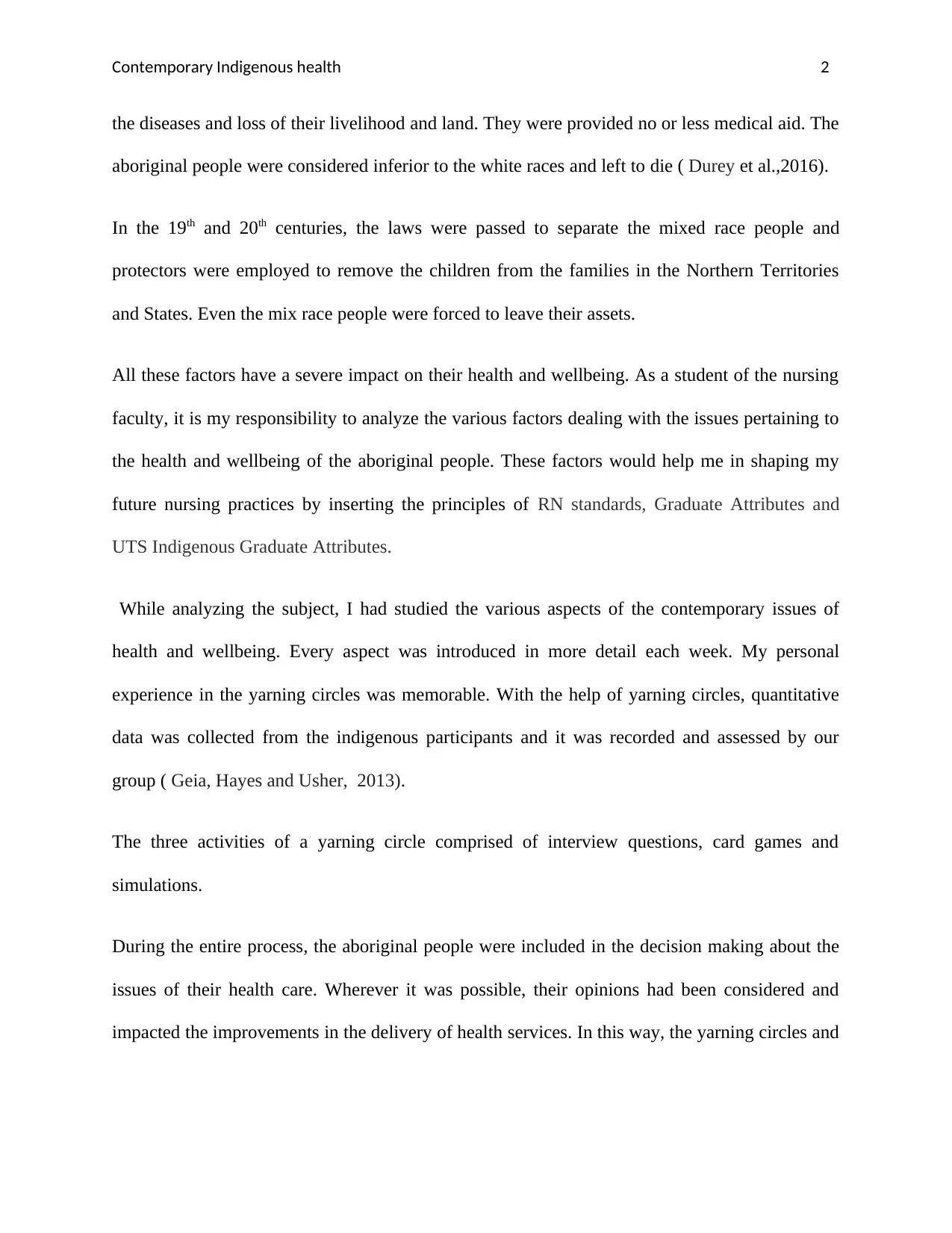
Contemporary Indigenous health 2
the diseases and loss of their livelihood and land. They were provided no or less medical aid. The
aboriginal people were considered inferior to the white races and left to die ( Durey et al.,2016).
In the 19th and 20th centuries, the laws were passed to separate the mixed race people and
protectors were employed to remove the children from the families in the Northern Territories
and States. Even the mix race people were forced to leave their assets.
All these factors have a severe impact on their health and wellbeing. As a student of the nursing
faculty, it is my responsibility to analyze the various factors dealing with the issues pertaining to
the health and wellbeing of the aboriginal people. These factors would help me in shaping my
future nursing practices by inserting the principles of RN standards, Graduate Attributes and
UTS Indigenous Graduate Attributes.
While analyzing the subject, I had studied the various aspects of the contemporary issues of
health and wellbeing. Every aspect was introduced in more detail each week. My personal
experience in the yarning circles was memorable. With the help of yarning circles, quantitative
data was collected from the indigenous participants and it was recorded and assessed by our
group ( Geia, Hayes and Usher, 2013).
The three activities of a yarning circle comprised of interview questions, card games and
simulations.
During the entire process, the aboriginal people were included in the decision making about the
issues of their health care. Wherever it was possible, their opinions had been considered and
impacted the improvements in the delivery of health services. In this way, the yarning circles and
the diseases and loss of their livelihood and land. They were provided no or less medical aid. The
aboriginal people were considered inferior to the white races and left to die ( Durey et al.,2016).
In the 19th and 20th centuries, the laws were passed to separate the mixed race people and
protectors were employed to remove the children from the families in the Northern Territories
and States. Even the mix race people were forced to leave their assets.
All these factors have a severe impact on their health and wellbeing. As a student of the nursing
faculty, it is my responsibility to analyze the various factors dealing with the issues pertaining to
the health and wellbeing of the aboriginal people. These factors would help me in shaping my
future nursing practices by inserting the principles of RN standards, Graduate Attributes and
UTS Indigenous Graduate Attributes.
While analyzing the subject, I had studied the various aspects of the contemporary issues of
health and wellbeing. Every aspect was introduced in more detail each week. My personal
experience in the yarning circles was memorable. With the help of yarning circles, quantitative
data was collected from the indigenous participants and it was recorded and assessed by our
group ( Geia, Hayes and Usher, 2013).
The three activities of a yarning circle comprised of interview questions, card games and
simulations.
During the entire process, the aboriginal people were included in the decision making about the
issues of their health care. Wherever it was possible, their opinions had been considered and
impacted the improvements in the delivery of health services. In this way, the yarning circles and
⊘ This is a preview!⊘
Do you want full access?
Subscribe today to unlock all pages.

Trusted by 1+ million students worldwide
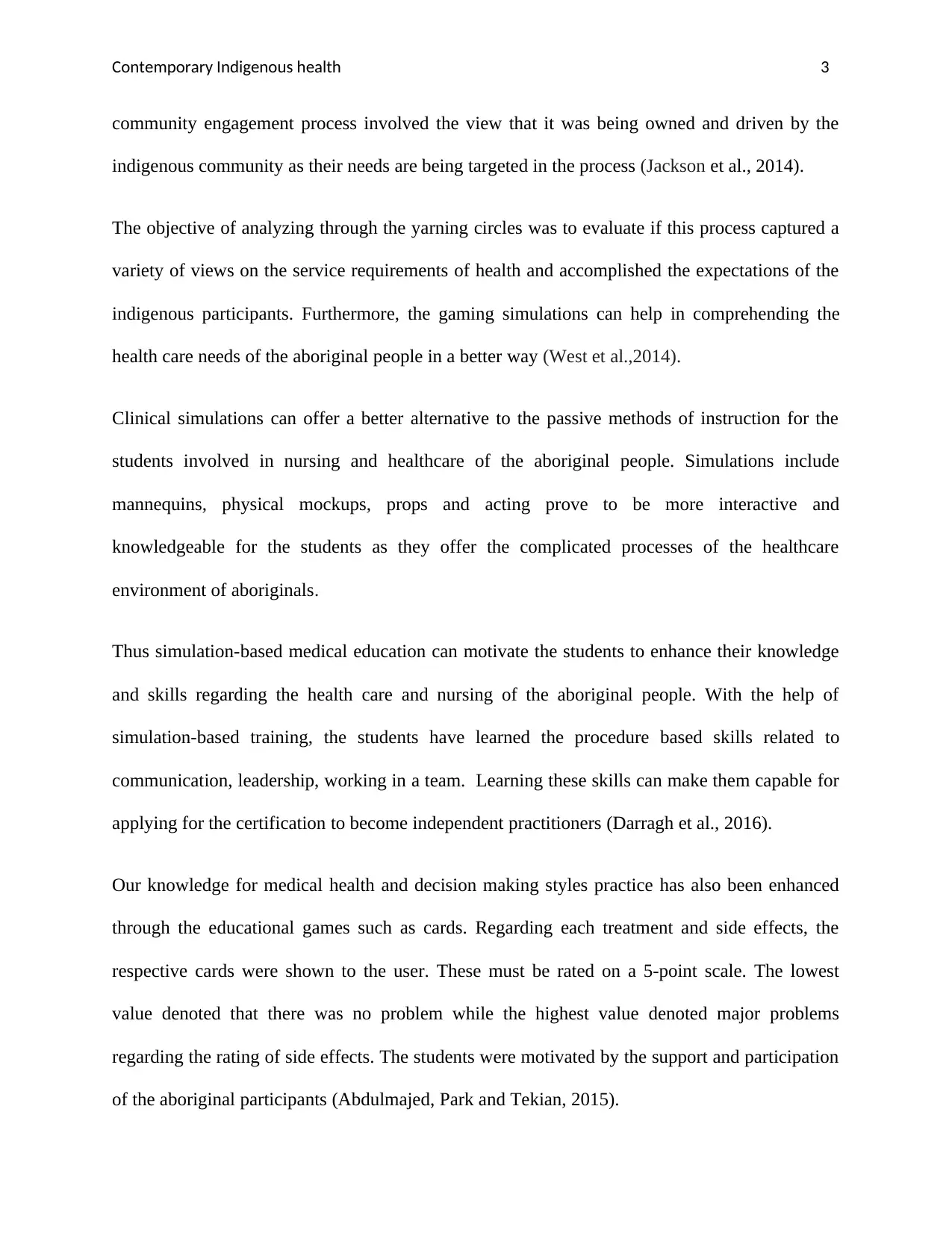
Contemporary Indigenous health 3
community engagement process involved the view that it was being owned and driven by the
indigenous community as their needs are being targeted in the process (Jackson et al., 2014).
The objective of analyzing through the yarning circles was to evaluate if this process captured a
variety of views on the service requirements of health and accomplished the expectations of the
indigenous participants. Furthermore, the gaming simulations can help in comprehending the
health care needs of the aboriginal people in a better way (West et al.,2014).
Clinical simulations can offer a better alternative to the passive methods of instruction for the
students involved in nursing and healthcare of the aboriginal people. Simulations include
mannequins, physical mockups, props and acting prove to be more interactive and
knowledgeable for the students as they offer the complicated processes of the healthcare
environment of aboriginals.
Thus simulation-based medical education can motivate the students to enhance their knowledge
and skills regarding the health care and nursing of the aboriginal people. With the help of
simulation-based training, the students have learned the procedure based skills related to
communication, leadership, working in a team. Learning these skills can make them capable for
applying for the certification to become independent practitioners (Darragh et al., 2016).
Our knowledge for medical health and decision making styles practice has also been enhanced
through the educational games such as cards. Regarding each treatment and side effects, the
respective cards were shown to the user. These must be rated on a 5-point scale. The lowest
value denoted that there was no problem while the highest value denoted major problems
regarding the rating of side effects. The students were motivated by the support and participation
of the aboriginal participants (Abdulmajed, Park and Tekian, 2015).
community engagement process involved the view that it was being owned and driven by the
indigenous community as their needs are being targeted in the process (Jackson et al., 2014).
The objective of analyzing through the yarning circles was to evaluate if this process captured a
variety of views on the service requirements of health and accomplished the expectations of the
indigenous participants. Furthermore, the gaming simulations can help in comprehending the
health care needs of the aboriginal people in a better way (West et al.,2014).
Clinical simulations can offer a better alternative to the passive methods of instruction for the
students involved in nursing and healthcare of the aboriginal people. Simulations include
mannequins, physical mockups, props and acting prove to be more interactive and
knowledgeable for the students as they offer the complicated processes of the healthcare
environment of aboriginals.
Thus simulation-based medical education can motivate the students to enhance their knowledge
and skills regarding the health care and nursing of the aboriginal people. With the help of
simulation-based training, the students have learned the procedure based skills related to
communication, leadership, working in a team. Learning these skills can make them capable for
applying for the certification to become independent practitioners (Darragh et al., 2016).
Our knowledge for medical health and decision making styles practice has also been enhanced
through the educational games such as cards. Regarding each treatment and side effects, the
respective cards were shown to the user. These must be rated on a 5-point scale. The lowest
value denoted that there was no problem while the highest value denoted major problems
regarding the rating of side effects. The students were motivated by the support and participation
of the aboriginal participants (Abdulmajed, Park and Tekian, 2015).
Paraphrase This Document
Need a fresh take? Get an instant paraphrase of this document with our AI Paraphraser
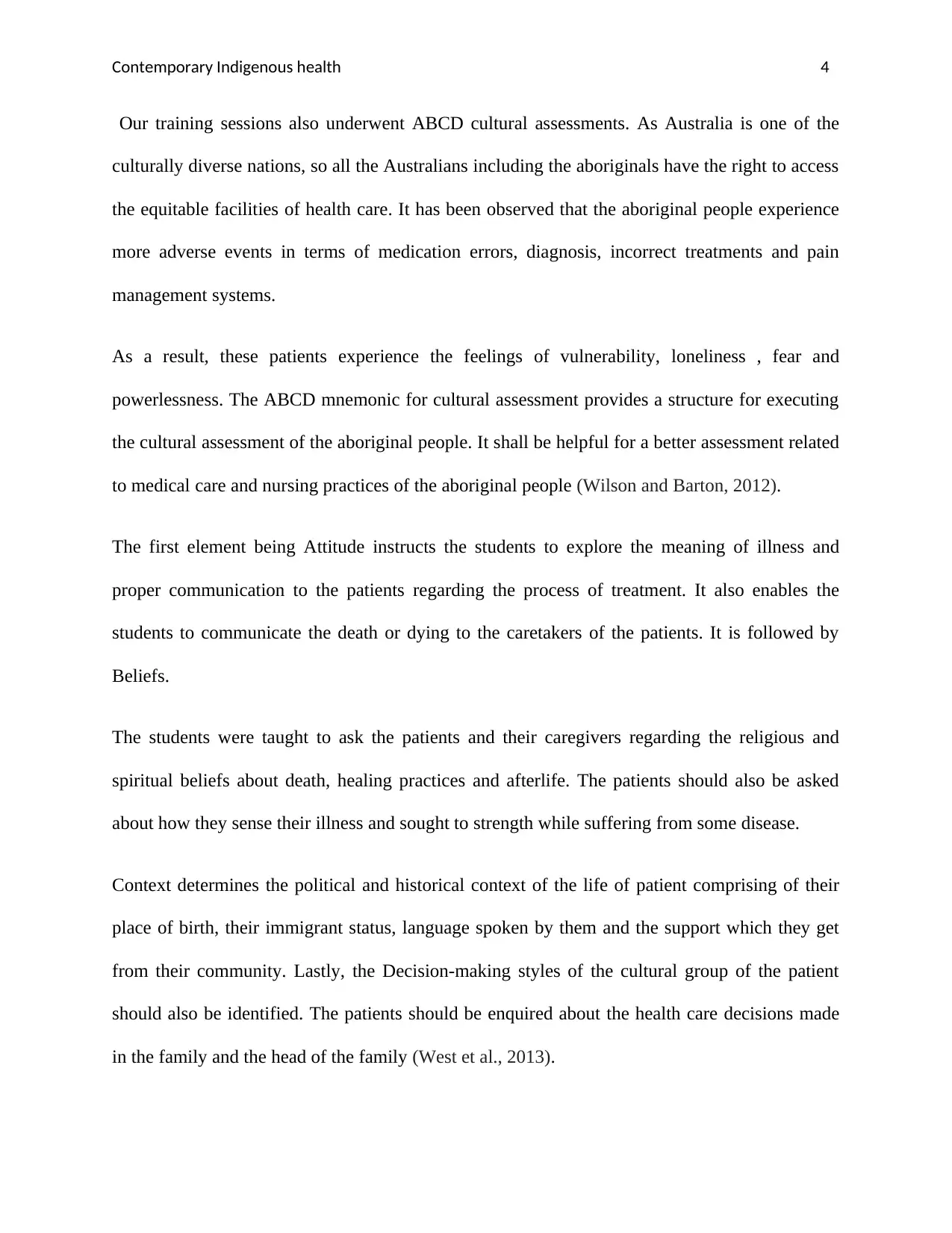
Contemporary Indigenous health 4
Our training sessions also underwent ABCD cultural assessments. As Australia is one of the
culturally diverse nations, so all the Australians including the aboriginals have the right to access
the equitable facilities of health care. It has been observed that the aboriginal people experience
more adverse events in terms of medication errors, diagnosis, incorrect treatments and pain
management systems.
As a result, these patients experience the feelings of vulnerability, loneliness , fear and
powerlessness. The ABCD mnemonic for cultural assessment provides a structure for executing
the cultural assessment of the aboriginal people. It shall be helpful for a better assessment related
to medical care and nursing practices of the aboriginal people (Wilson and Barton, 2012).
The first element being Attitude instructs the students to explore the meaning of illness and
proper communication to the patients regarding the process of treatment. It also enables the
students to communicate the death or dying to the caretakers of the patients. It is followed by
Beliefs.
The students were taught to ask the patients and their caregivers regarding the religious and
spiritual beliefs about death, healing practices and afterlife. The patients should also be asked
about how they sense their illness and sought to strength while suffering from some disease.
Context determines the political and historical context of the life of patient comprising of their
place of birth, their immigrant status, language spoken by them and the support which they get
from their community. Lastly, the Decision-making styles of the cultural group of the patient
should also be identified. The patients should be enquired about the health care decisions made
in the family and the head of the family (West et al., 2013).
Our training sessions also underwent ABCD cultural assessments. As Australia is one of the
culturally diverse nations, so all the Australians including the aboriginals have the right to access
the equitable facilities of health care. It has been observed that the aboriginal people experience
more adverse events in terms of medication errors, diagnosis, incorrect treatments and pain
management systems.
As a result, these patients experience the feelings of vulnerability, loneliness , fear and
powerlessness. The ABCD mnemonic for cultural assessment provides a structure for executing
the cultural assessment of the aboriginal people. It shall be helpful for a better assessment related
to medical care and nursing practices of the aboriginal people (Wilson and Barton, 2012).
The first element being Attitude instructs the students to explore the meaning of illness and
proper communication to the patients regarding the process of treatment. It also enables the
students to communicate the death or dying to the caretakers of the patients. It is followed by
Beliefs.
The students were taught to ask the patients and their caregivers regarding the religious and
spiritual beliefs about death, healing practices and afterlife. The patients should also be asked
about how they sense their illness and sought to strength while suffering from some disease.
Context determines the political and historical context of the life of patient comprising of their
place of birth, their immigrant status, language spoken by them and the support which they get
from their community. Lastly, the Decision-making styles of the cultural group of the patient
should also be identified. The patients should be enquired about the health care decisions made
in the family and the head of the family (West et al., 2013).
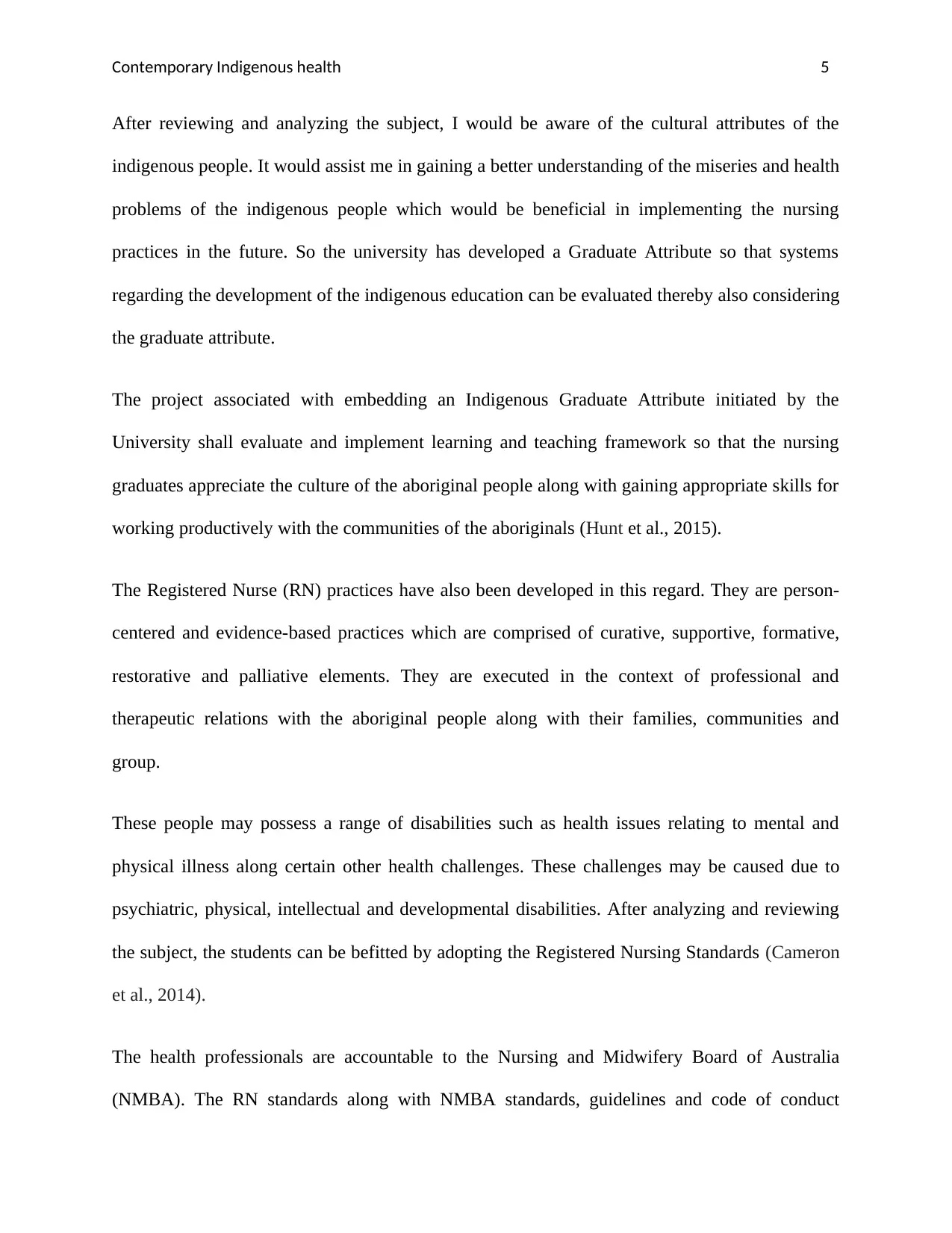
Contemporary Indigenous health 5
After reviewing and analyzing the subject, I would be aware of the cultural attributes of the
indigenous people. It would assist me in gaining a better understanding of the miseries and health
problems of the indigenous people which would be beneficial in implementing the nursing
practices in the future. So the university has developed a Graduate Attribute so that systems
regarding the development of the indigenous education can be evaluated thereby also considering
the graduate attribute.
The project associated with embedding an Indigenous Graduate Attribute initiated by the
University shall evaluate and implement learning and teaching framework so that the nursing
graduates appreciate the culture of the aboriginal people along with gaining appropriate skills for
working productively with the communities of the aboriginals (Hunt et al., 2015).
The Registered Nurse (RN) practices have also been developed in this regard. They are person-
centered and evidence-based practices which are comprised of curative, supportive, formative,
restorative and palliative elements. They are executed in the context of professional and
therapeutic relations with the aboriginal people along with their families, communities and
group.
These people may possess a range of disabilities such as health issues relating to mental and
physical illness along certain other health challenges. These challenges may be caused due to
psychiatric, physical, intellectual and developmental disabilities. After analyzing and reviewing
the subject, the students can be befitted by adopting the Registered Nursing Standards (Cameron
et al., 2014).
The health professionals are accountable to the Nursing and Midwifery Board of Australia
(NMBA). The RN standards along with NMBA standards, guidelines and code of conduct
After reviewing and analyzing the subject, I would be aware of the cultural attributes of the
indigenous people. It would assist me in gaining a better understanding of the miseries and health
problems of the indigenous people which would be beneficial in implementing the nursing
practices in the future. So the university has developed a Graduate Attribute so that systems
regarding the development of the indigenous education can be evaluated thereby also considering
the graduate attribute.
The project associated with embedding an Indigenous Graduate Attribute initiated by the
University shall evaluate and implement learning and teaching framework so that the nursing
graduates appreciate the culture of the aboriginal people along with gaining appropriate skills for
working productively with the communities of the aboriginals (Hunt et al., 2015).
The Registered Nurse (RN) practices have also been developed in this regard. They are person-
centered and evidence-based practices which are comprised of curative, supportive, formative,
restorative and palliative elements. They are executed in the context of professional and
therapeutic relations with the aboriginal people along with their families, communities and
group.
These people may possess a range of disabilities such as health issues relating to mental and
physical illness along certain other health challenges. These challenges may be caused due to
psychiatric, physical, intellectual and developmental disabilities. After analyzing and reviewing
the subject, the students can be befitted by adopting the Registered Nursing Standards (Cameron
et al., 2014).
The health professionals are accountable to the Nursing and Midwifery Board of Australia
(NMBA). The RN standards along with NMBA standards, guidelines and code of conduct
⊘ This is a preview!⊘
Do you want full access?
Subscribe today to unlock all pages.

Trusted by 1+ million students worldwide
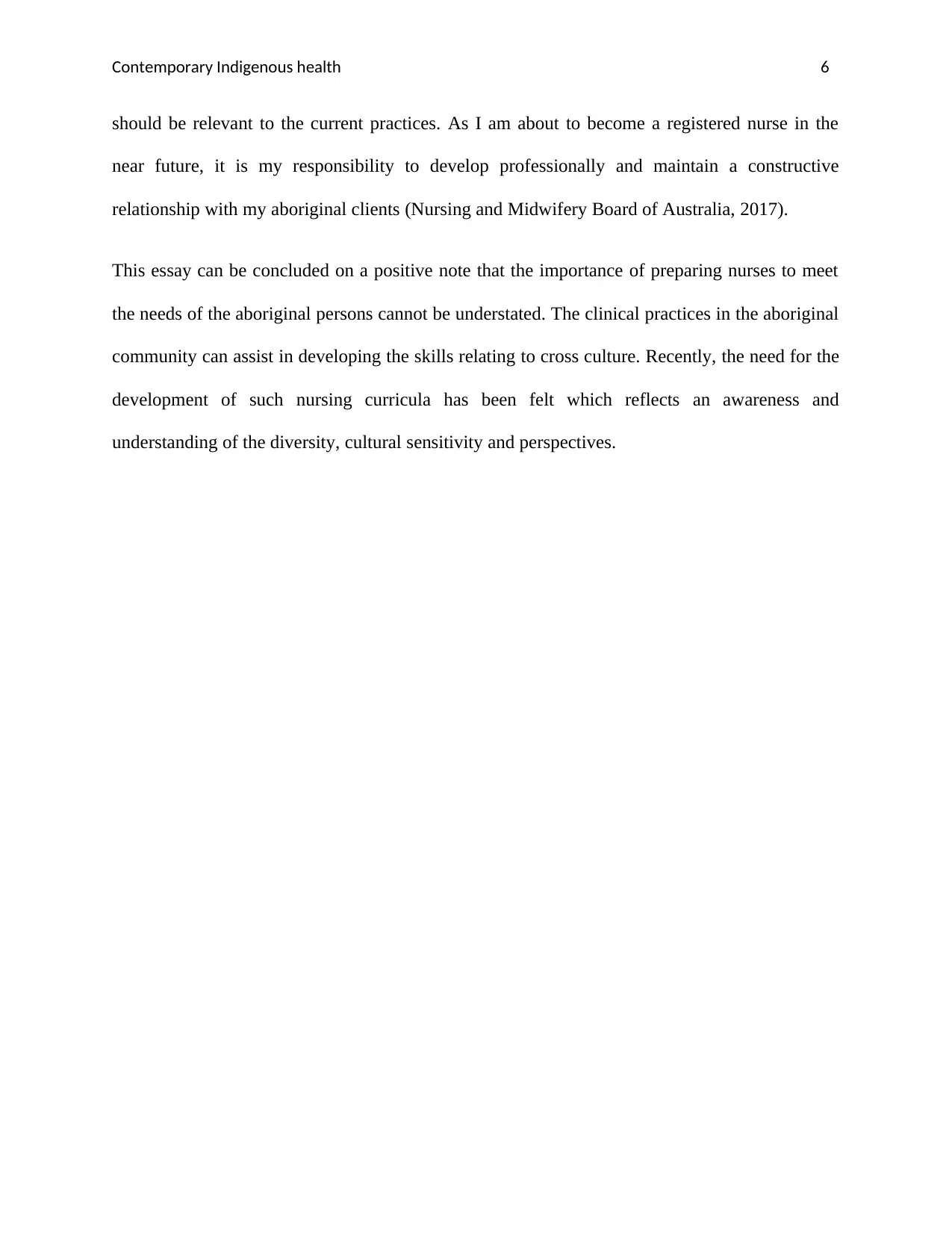
Contemporary Indigenous health 6
should be relevant to the current practices. As I am about to become a registered nurse in the
near future, it is my responsibility to develop professionally and maintain a constructive
relationship with my aboriginal clients (Nursing and Midwifery Board of Australia, 2017).
This essay can be concluded on a positive note that the importance of preparing nurses to meet
the needs of the aboriginal persons cannot be understated. The clinical practices in the aboriginal
community can assist in developing the skills relating to cross culture. Recently, the need for the
development of such nursing curricula has been felt which reflects an awareness and
understanding of the diversity, cultural sensitivity and perspectives.
should be relevant to the current practices. As I am about to become a registered nurse in the
near future, it is my responsibility to develop professionally and maintain a constructive
relationship with my aboriginal clients (Nursing and Midwifery Board of Australia, 2017).
This essay can be concluded on a positive note that the importance of preparing nurses to meet
the needs of the aboriginal persons cannot be understated. The clinical practices in the aboriginal
community can assist in developing the skills relating to cross culture. Recently, the need for the
development of such nursing curricula has been felt which reflects an awareness and
understanding of the diversity, cultural sensitivity and perspectives.
Paraphrase This Document
Need a fresh take? Get an instant paraphrase of this document with our AI Paraphraser
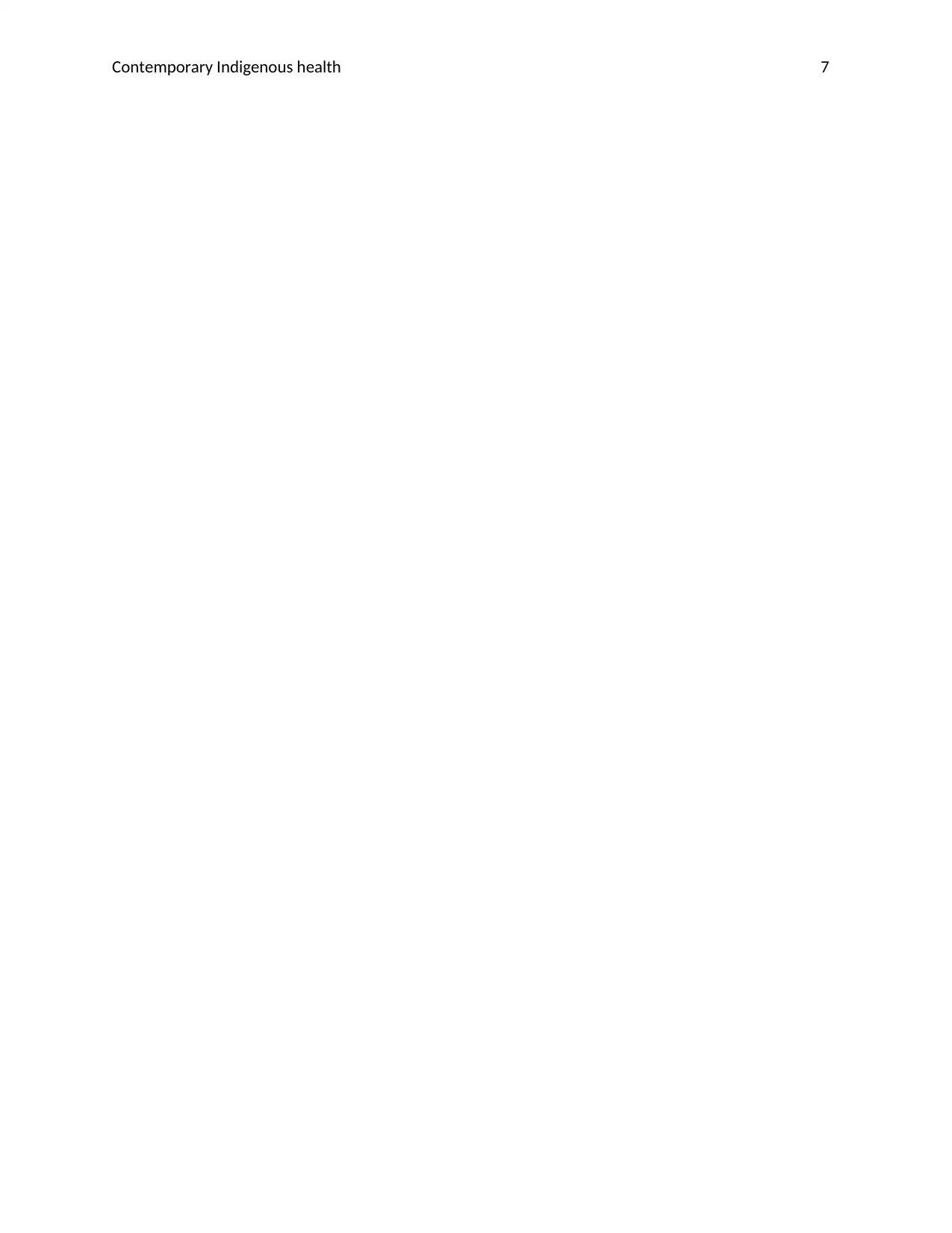
Contemporary Indigenous health 7
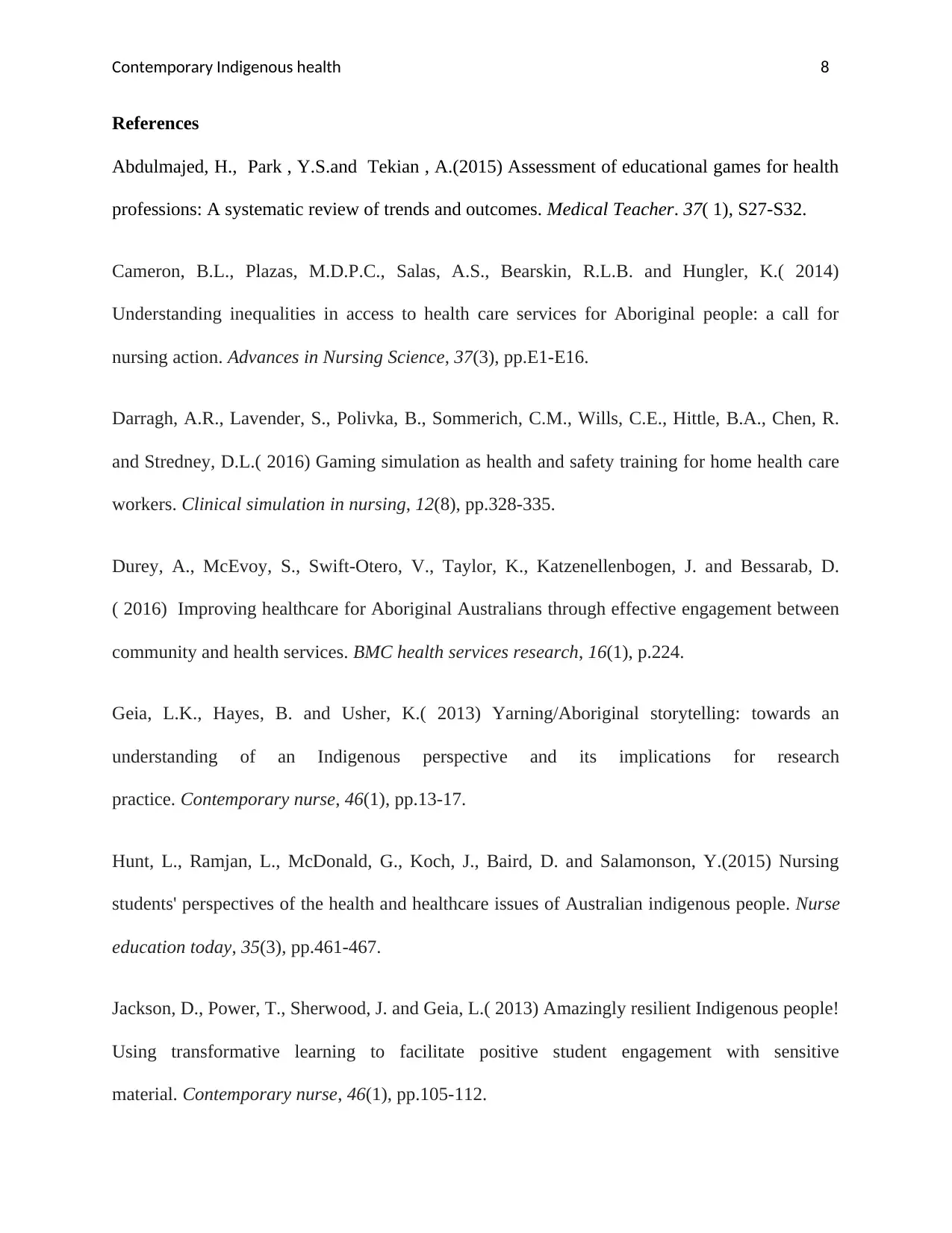
Contemporary Indigenous health 8
References
Abdulmajed, H., Park , Y.S.and Tekian , A.(2015) Assessment of educational games for health
professions: A systematic review of trends and outcomes. Medical Teacher. 37( 1), S27-S32.
Cameron, B.L., Plazas, M.D.P.C., Salas, A.S., Bearskin, R.L.B. and Hungler, K.( 2014)
Understanding inequalities in access to health care services for Aboriginal people: a call for
nursing action. Advances in Nursing Science, 37(3), pp.E1-E16.
Darragh, A.R., Lavender, S., Polivka, B., Sommerich, C.M., Wills, C.E., Hittle, B.A., Chen, R.
and Stredney, D.L.( 2016) Gaming simulation as health and safety training for home health care
workers. Clinical simulation in nursing, 12(8), pp.328-335.
Durey, A., McEvoy, S., Swift-Otero, V., Taylor, K., Katzenellenbogen, J. and Bessarab, D.
( 2016) Improving healthcare for Aboriginal Australians through effective engagement between
community and health services. BMC health services research, 16(1), p.224.
Geia, L.K., Hayes, B. and Usher, K.( 2013) Yarning/Aboriginal storytelling: towards an
understanding of an Indigenous perspective and its implications for research
practice. Contemporary nurse, 46(1), pp.13-17.
Hunt, L., Ramjan, L., McDonald, G., Koch, J., Baird, D. and Salamonson, Y.(2015) Nursing
students' perspectives of the health and healthcare issues of Australian indigenous people. Nurse
education today, 35(3), pp.461-467.
Jackson, D., Power, T., Sherwood, J. and Geia, L.( 2013) Amazingly resilient Indigenous people!
Using transformative learning to facilitate positive student engagement with sensitive
material. Contemporary nurse, 46(1), pp.105-112.
References
Abdulmajed, H., Park , Y.S.and Tekian , A.(2015) Assessment of educational games for health
professions: A systematic review of trends and outcomes. Medical Teacher. 37( 1), S27-S32.
Cameron, B.L., Plazas, M.D.P.C., Salas, A.S., Bearskin, R.L.B. and Hungler, K.( 2014)
Understanding inequalities in access to health care services for Aboriginal people: a call for
nursing action. Advances in Nursing Science, 37(3), pp.E1-E16.
Darragh, A.R., Lavender, S., Polivka, B., Sommerich, C.M., Wills, C.E., Hittle, B.A., Chen, R.
and Stredney, D.L.( 2016) Gaming simulation as health and safety training for home health care
workers. Clinical simulation in nursing, 12(8), pp.328-335.
Durey, A., McEvoy, S., Swift-Otero, V., Taylor, K., Katzenellenbogen, J. and Bessarab, D.
( 2016) Improving healthcare for Aboriginal Australians through effective engagement between
community and health services. BMC health services research, 16(1), p.224.
Geia, L.K., Hayes, B. and Usher, K.( 2013) Yarning/Aboriginal storytelling: towards an
understanding of an Indigenous perspective and its implications for research
practice. Contemporary nurse, 46(1), pp.13-17.
Hunt, L., Ramjan, L., McDonald, G., Koch, J., Baird, D. and Salamonson, Y.(2015) Nursing
students' perspectives of the health and healthcare issues of Australian indigenous people. Nurse
education today, 35(3), pp.461-467.
Jackson, D., Power, T., Sherwood, J. and Geia, L.( 2013) Amazingly resilient Indigenous people!
Using transformative learning to facilitate positive student engagement with sensitive
material. Contemporary nurse, 46(1), pp.105-112.
⊘ This is a preview!⊘
Do you want full access?
Subscribe today to unlock all pages.

Trusted by 1+ million students worldwide
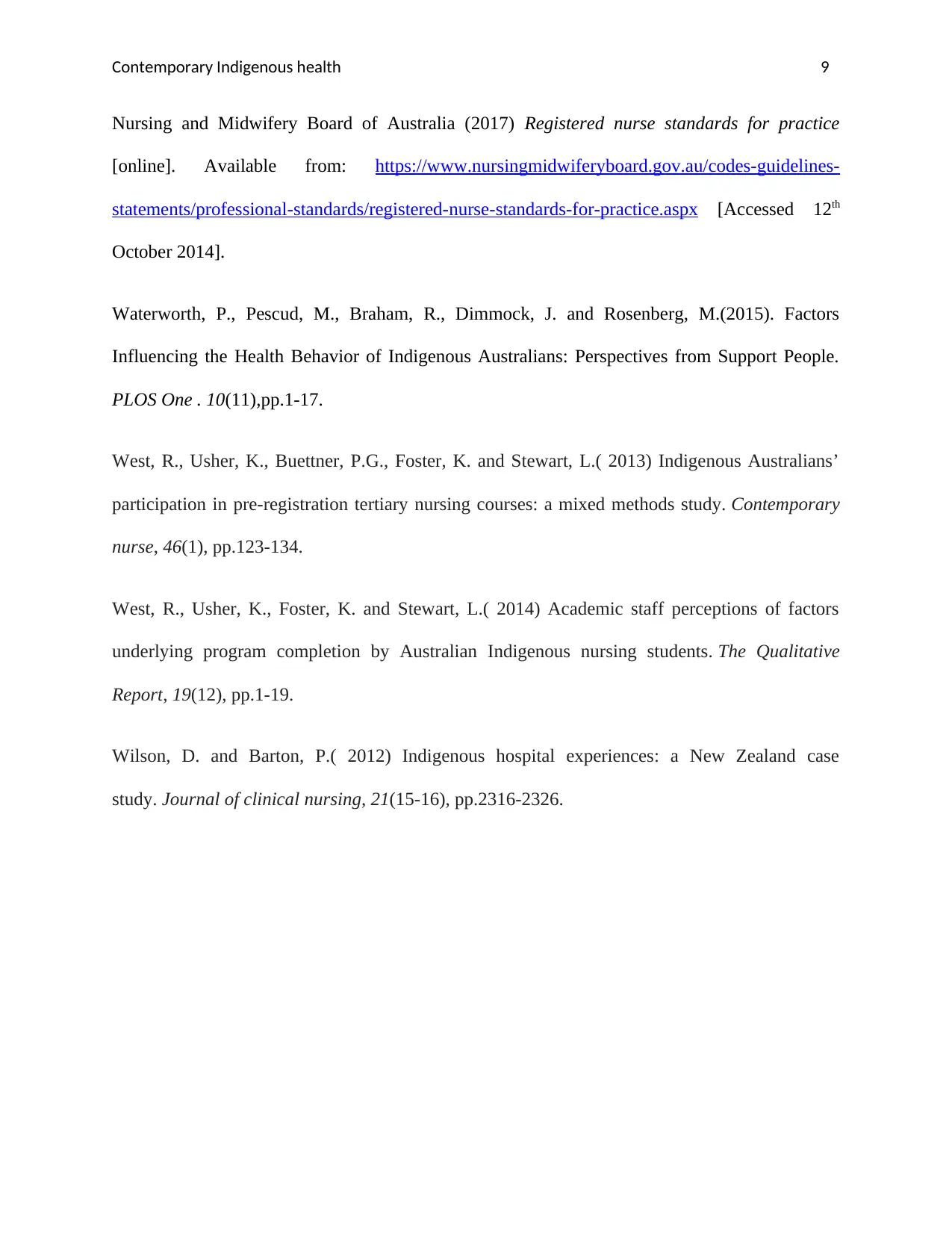
Contemporary Indigenous health 9
Nursing and Midwifery Board of Australia (2017) Registered nurse standards for practice
[online]. Available from: https://www.nursingmidwiferyboard.gov.au/codes-guidelines-
statements/professional-standards/registered-nurse-standards-for-practice.aspx [Accessed 12th
October 2014].
Waterworth, P., Pescud, M., Braham, R., Dimmock, J. and Rosenberg, M.(2015). Factors
Influencing the Health Behavior of Indigenous Australians: Perspectives from Support People.
PLOS One . 10(11),pp.1-17.
West, R., Usher, K., Buettner, P.G., Foster, K. and Stewart, L.( 2013) Indigenous Australians’
participation in pre-registration tertiary nursing courses: a mixed methods study. Contemporary
nurse, 46(1), pp.123-134.
West, R., Usher, K., Foster, K. and Stewart, L.( 2014) Academic staff perceptions of factors
underlying program completion by Australian Indigenous nursing students. The Qualitative
Report, 19(12), pp.1-19.
Wilson, D. and Barton, P.( 2012) Indigenous hospital experiences: a New Zealand case
study. Journal of clinical nursing, 21(15‐16), pp.2316-2326.
Nursing and Midwifery Board of Australia (2017) Registered nurse standards for practice
[online]. Available from: https://www.nursingmidwiferyboard.gov.au/codes-guidelines-
statements/professional-standards/registered-nurse-standards-for-practice.aspx [Accessed 12th
October 2014].
Waterworth, P., Pescud, M., Braham, R., Dimmock, J. and Rosenberg, M.(2015). Factors
Influencing the Health Behavior of Indigenous Australians: Perspectives from Support People.
PLOS One . 10(11),pp.1-17.
West, R., Usher, K., Buettner, P.G., Foster, K. and Stewart, L.( 2013) Indigenous Australians’
participation in pre-registration tertiary nursing courses: a mixed methods study. Contemporary
nurse, 46(1), pp.123-134.
West, R., Usher, K., Foster, K. and Stewart, L.( 2014) Academic staff perceptions of factors
underlying program completion by Australian Indigenous nursing students. The Qualitative
Report, 19(12), pp.1-19.
Wilson, D. and Barton, P.( 2012) Indigenous hospital experiences: a New Zealand case
study. Journal of clinical nursing, 21(15‐16), pp.2316-2326.
1 out of 10
Related Documents
Your All-in-One AI-Powered Toolkit for Academic Success.
+13062052269
info@desklib.com
Available 24*7 on WhatsApp / Email
![[object Object]](/_next/static/media/star-bottom.7253800d.svg)
Unlock your academic potential
Copyright © 2020–2025 A2Z Services. All Rights Reserved. Developed and managed by ZUCOL.




